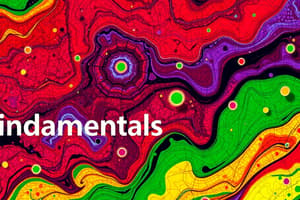Podcast
Questions and Answers
What is a primary characteristic that sets geospatial data apart from other types of data?
What is a primary characteristic that sets geospatial data apart from other types of data?
- It emphasizes statistical trends over geographic information.
- It describes objects or phenomena with a specific location in the real world. (correct)
- It focuses solely on economic data without spatial elements.
- It describes objects or phenomena with a specific time frame.
Which of the following is NOT an application of geospatial data?
Which of the following is NOT an application of geospatial data?
- Credit card payments.
- Statistical analysis of textual data. (correct)
- Census demographics.
- Environmental records.
How are the visualization parameters in mapping spatial data utilized?
How are the visualization parameters in mapping spatial data utilized?
- To enhance the visual appeal without conveying specific information.
- To highlight irrelevant elements in the data.
- To simplify data by removing important features.
- To show additional information about the objects under consideration. (correct)
What is the basic visualization strategy for managing large spatial data sets?
What is the basic visualization strategy for managing large spatial data sets?
Which of the following visualization techniques is NOT typically associated with geospatial data?
Which of the following visualization techniques is NOT typically associated with geospatial data?
What is one way large spatial data sets often arise?
What is one way large spatial data sets often arise?
Which type of techniques is applicable to multivariate data visualization?
Which type of techniques is applicable to multivariate data visualization?
In the context of geovisualization, which aspect is essential for understanding relationships involving geographic location?
In the context of geovisualization, which aspect is essential for understanding relationships involving geographic location?
What is the main characteristic of bar charts and histograms?
What is the main characteristic of bar charts and histograms?
When is it preferable to use a stacked bar graph over adjacent bars?
When is it preferable to use a stacked bar graph over adjacent bars?
Which factor plays a critical role in deciding the number of bars in a bar chart?
Which factor plays a critical role in deciding the number of bars in a bar chart?
What method is suggested for representing a large range of continuous data in a bar chart?
What method is suggested for representing a large range of continuous data in a bar chart?
What is one advantage of using horizontally oriented bars in a bar chart?
What is one advantage of using horizontally oriented bars in a bar chart?
In what situation should a histogram be used instead of a standard bar chart?
In what situation should a histogram be used instead of a standard bar chart?
What is typically varied in stacked bar graphs to distinguish between dimensions?
What is typically varied in stacked bar graphs to distinguish between dimensions?
What is a potential disadvantage of using adjacent bars in bar charts?
What is a potential disadvantage of using adjacent bars in bar charts?
Which algorithm is NOT mentioned as a common optimization technique used in label placement?
Which algorithm is NOT mentioned as a common optimization technique used in label placement?
What is one major benefit of integrating advanced visualization functions with GIS?
What is one major benefit of integrating advanced visualization functions with GIS?
Which of the following best describes a GIS?
Which of the following best describes a GIS?
What characterizes point-based visualization techniques?
What characterizes point-based visualization techniques?
Which of the following technologies is mentioned as contributing to the advancement of GIS tools?
Which of the following technologies is mentioned as contributing to the advancement of GIS tools?
What is primarily focused on in the chapter regarding multivariate data?
What is primarily focused on in the chapter regarding multivariate data?
What is one result of increased geospatial data visualization capabilities?
What is one result of increased geospatial data visualization capabilities?
Which of the following statements is true regarding label placement algorithms?
Which of the following statements is true regarding label placement algorithms?
What type of visualization involves the aggregation of point data and mapping it to the areas' size?
What type of visualization involves the aggregation of point data and mapping it to the areas' size?
Which term describes data that is defined at all locations and can change gradually?
Which term describes data that is defined at all locations and can change gradually?
In geovisualization, what is a major advantage of interactive maps compared to traditional cartography?
In geovisualization, what is a major advantage of interactive maps compared to traditional cartography?
What must a designer consider when displaying point data?
What must a designer consider when displaying point data?
Which statement about dot maps is true?
Which statement about dot maps is true?
Which technique allows linking multiple maps with statistical visualizations?
Which technique allows linking multiple maps with statistical visualizations?
What is a key challenge when scaling symbols in dot maps?
What is a key challenge when scaling symbols in dot maps?
What does the term 'abrupt data' refer to in data visualization?
What does the term 'abrupt data' refer to in data visualization?
What does a line graph primarily represent on its vertical and horizontal axes?
What does a line graph primarily represent on its vertical and horizontal axes?
What is one major limitation of using superimposed line graphs with a large number of dimensions?
What is one major limitation of using superimposed line graphs with a large number of dimensions?
What is the purpose of using parallel coordinates in multivariate data analysis?
What is the purpose of using parallel coordinates in multivariate data analysis?
In parallel coordinates, what does a data point represented as a polyline indicate?
In parallel coordinates, what does a data point represented as a polyline indicate?
Which of the following features in parallel coordinates indicates outliers?
Which of the following features in parallel coordinates indicates outliers?
What is one function of using different colors or line styles in line graphs?
What is one function of using different colors or line styles in line graphs?
What improvement in parallel coordinates allows users to explore relationships across all dimensions?
What improvement in parallel coordinates allows users to explore relationships across all dimensions?
How are axes represented in parallel coordinates compared to traditional graphs?
How are axes represented in parallel coordinates compared to traditional graphs?
What type of mapping utilizes distinct graphical attributes for each data attribute?
What type of mapping utilizes distinct graphical attributes for each data attribute?
Why are one-to-many mappings considered beneficial?
Why are one-to-many mappings considered beneficial?
In which scenario are many-to-one mappings most effectively used?
In which scenario are many-to-one mappings most effectively used?
Which graphical attribute is commonly judged more accurately than others?
Which graphical attribute is commonly judged more accurately than others?
What is a significant limitation of using glyphs for data visualization?
What is a significant limitation of using glyphs for data visualization?
What is an advantage of mapping population to both size and color?
What is an advantage of mapping population to both size and color?
How many different dimension orderings can be used in glyph mapping once a design is chosen?
How many different dimension orderings can be used in glyph mapping once a design is chosen?
Which factor is most easily perceived by users when comparing adjacent graphical attributes?
Which factor is most easily perceived by users when comparing adjacent graphical attributes?
Flashcards
Geospatial Data
Geospatial Data
Data that describes objects or phenomena with a specific location in the real world. Examples include credit card payments, telephone calls, and environmental records.
Geovisualization
Geovisualization
The use of visual representations to analyze and understand geospatial data. It often involves mapping spatial attributes to screen dimensions.
Spatial Data Sets
Spatial Data Sets
Discrete samples of a continuous phenomenon that occur in space. Examples include measuring temperature across a region.
Basic Visualization Strategy for Spatial Data
Basic Visualization Strategy for Spatial Data
Signup and view all the flashcards
Visualization of Point Data
Visualization of Point Data
Signup and view all the flashcards
Visualization of Line Data
Visualization of Line Data
Signup and view all the flashcards
Visualization of Area Data
Visualization of Area Data
Signup and view all the flashcards
Visualization Parameters for Spatial Data
Visualization Parameters for Spatial Data
Signup and view all the flashcards
Dot map
Dot map
Signup and view all the flashcards
Isoline map
Isoline map
Signup and view all the flashcards
Cartogram
Cartogram
Signup and view all the flashcards
Exploratory geovisualization
Exploratory geovisualization
Signup and view all the flashcards
Point data
Point data
Signup and view all the flashcards
Continuous visualization of point data
Continuous visualization of point data
Signup and view all the flashcards
Discrete visualization of point data
Discrete visualization of point data
Signup and view all the flashcards
Smooth data
Smooth data
Signup and view all the flashcards
Map Labeling Algorithms
Map Labeling Algorithms
Signup and view all the flashcards
Rule-Based Label Placement
Rule-Based Label Placement
Signup and view all the flashcards
Labeling Software
Labeling Software
Signup and view all the flashcards
Geographic Information Systems (GIS)
Geographic Information Systems (GIS)
Signup and view all the flashcards
Geospatial Data Visualization
Geospatial Data Visualization
Signup and view all the flashcards
Multivariate Data Visualization
Multivariate Data Visualization
Signup and view all the flashcards
Point Plots
Point Plots
Signup and view all the flashcards
Marks in Point Plots
Marks in Point Plots
Signup and view all the flashcards
Bar Chart
Bar Chart
Signup and view all the flashcards
Stacked Bar Graph
Stacked Bar Graph
Signup and view all the flashcards
Adjacent Bars
Adjacent Bars
Signup and view all the flashcards
Number of Bars
Number of Bars
Signup and view all the flashcards
Bar Orientation
Bar Orientation
Signup and view all the flashcards
Tabular Displays
Tabular Displays
Signup and view all the flashcards
Visual Acuity for Length
Visual Acuity for Length
Signup and view all the flashcards
Line Graph
Line Graph
Signup and view all the flashcards
Univariate Techniques for Multivariate Data
Univariate Techniques for Multivariate Data
Signup and view all the flashcards
Superimposed Line Graphs
Superimposed Line Graphs
Signup and view all the flashcards
Parallel Coordinates
Parallel Coordinates
Signup and view all the flashcards
Clusters of Similar Lines in Parallel Coordinates
Clusters of Similar Lines in Parallel Coordinates
Signup and view all the flashcards
Similar Crossing Points in Parallel Coordinates
Similar Crossing Points in Parallel Coordinates
Signup and view all the flashcards
Isolated or Differently Sloped Lines in Parallel Coordinates
Isolated or Differently Sloped Lines in Parallel Coordinates
Signup and view all the flashcards
Limitations of Parallel Coordinates
Limitations of Parallel Coordinates
Signup and view all the flashcards
One-to-one Mapping
One-to-one Mapping
Signup and view all the flashcards
One-to-many Mapping
One-to-many Mapping
Signup and view all the flashcards
Many-to-one Mapping
Many-to-one Mapping
Signup and view all the flashcards
Perceptual Biases
Perceptual Biases
Signup and view all the flashcards
Proximity Bias
Proximity Bias
Signup and view all the flashcards
Spatial Proximity Bias
Spatial Proximity Bias
Signup and view all the flashcards
Glyph Visualization Limitations
Glyph Visualization Limitations
Signup and view all the flashcards
Dimension Ordering
Dimension Ordering
Signup and view all the flashcards
Study Notes
Geospatial Data
- Geospatial data describes objects/phenomena with specific locations in the real world
- Examples include credit card transactions, phone calls, environmental records, and census demographics
- Often represented as samples of continuous phenomena in two dimensions
Visualizing Spatial Data
- Large spatial datasets result from accumulating real-world samples
- Spatial data sets are often discrete samples of continuous phenomena
- Modern applications often require analyzing relationships involving geographic location (e.g., climate modeling, environmental monitoring, social/economic indicators)
Visualizing Point Data (Dot Maps)
- Visualize point phenomena by placing a symbol at their location
- Can use symbol size or color to represent quantitative data
- Symbol scaling can be complex to correctly perceive
- Dot maps are useful for visualizing point-based geographic data
PixelMaps
- Avoids overlap by repositioning pixels
- Data set partitioned recursively into four equal-sized subregions
- Efficiency dependent on structuring the data appropriately
- Useful for avoiding visual clutter in large spatial data sets
Network Maps
- Display the connectivity of networks
- Focus on general behaviour and structure
- Can display hierarchical information
- Use color and shape to code node or link info
- Useful for investigating large network structures (e.g., internet traffic)
Flow Maps & Edge Bundling
- Minimize edge crossings and maintain relative node positions
- Hierarchical clustering assists in merging and rerouting flows
- Clutter reduction, clear visualization of flow patterns (e.g., tourist flows)
- Edge bundling avoids overlaps by representing connections with curved lines
Thematic Maps (Choropleth Maps)
- Encodes attribute values as color
- Assumes attribute is uniformly distributed within areas
- Regions are often pre-defined, based on existing geographic divisions
- Useful for depicting spatial variability of a phenomenon (e.g., election results)
Cartograms
- Regions are rescaled according to a variable, distorting geography
- Minimizes visual clutter in regions with high density
- Depicts spatial distribution of a phenomenon (e.g., population distribution)
Other Issues in Geospatial Data Visualization
- Map Generalization: Selecting relevant data for a specific application
- Map Labeling: Placing labels to enhance comprehension
- Choosing effective visual representations for clarity and ease of interpretation
- Data ordering may affect the analysis based on visual characteristics such as cluster separation and visual prominence
Studying That Suits You
Use AI to generate personalized quizzes and flashcards to suit your learning preferences.

![[05/Rokel/10]](https://images.unsplash.com/photo-1498050108023-c5249f4df085?ixid=M3w0MjA4MDF8MHwxfHNlYXJjaHwzfHxkZWNrLmdsJTIwZGF0YSUyMHZpc3VhbGl6YXRpb24lMjBnZW9zcGF0aWFsJTIwZGF0YSUyMHdlYiUyMGFwcGxpY2F0aW9uc3xlbnwxfDB8fHwxNzA2NDc5ODY0fDA&ixlib=rb-4.0.3&w=300&fit=crop&h=200&q=75&fm=webp)


